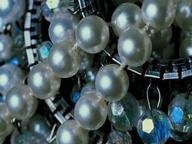Quiz Answer Key and Fun Facts
1. This stone has a standard cut frequently seen in modern jewellery. Outshining the gemstone cuts of previous centuries with its 58 facets showing off the stone's innate radiance, what is this cut called?
2. Diamonds and other gemstones are often faceted to allow light to play around within them, enhancing their 'fire'. An alternative, most commonly used for opaque gems which don't sparkle no matter how they are cut, is to have them cut into a rounded shape with a flat bottom. What is the name of this cut as seen in the photo?
3. While many stones are cut to enhance their sparkle, some gems are cut into the form shown in the photo. This cut enhances the lustre and clarity of the stone rather than the sparkle. Which cut, named after a gemstone, is this?
4. The smaller stones with the arrows pointing to them in the photo are a cousin to the photo in the previous question. They both have a rectilinear form but the proportions are different, these stones being rather longer in proportion to the width. Named for a type of bread, what are these stones called?
5. These two rose quartz stones have been fashioned to hang as beads, perhaps as earrings or from a necklace. Popular in the Victorian era, what cut has been used on these stone?
6. You've spotted a piece of jewellery with the stones firmly set into it, sitting next to each other in a trough. Your memory fails you so you enter the store to ask what that setting is called. What does the jeweller call this setting?
7. One of the earliest forms of attaching gemstones to metal was to surround it with a strip of metal to hold it in place, as in the photograph. What is this setting called?
8. The gemstone cut in the picture made its debut in the 1960s having been developed from the French cut. The sparkle gained from this style of cut has become increasingly popular. What name was given to this particular cut?
9. This ring looks like it's been made to resemble a cobblestone road. With its multitude of smaller stones covering most, if not all of the metallic surface of the ring, what is the name of this type of setting?
10. Legend has it that this cut is named after a certain Madame de Pompadour, mistress of Louis XV. Louis is said to have commissioned this cut for her near the beginning of their relationship in 1745. Named for Madame de Pompadour's title at court, what is this cut called?
Source: Author
Tizzabelle
This quiz was reviewed by FunTrivia editor
kyleisalive before going online.
Any errors found in FunTrivia content are routinely corrected through our feedback system.

